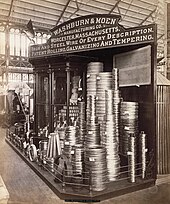
Barbed wire, also known as barb wire, is a type of steel fencing wire constructed with sharp edges or points arranged at intervals along the strands. Its primary use is the construction of inexpensive fences, and it is also used as a security measure atop walls surrounding property. As a wire obstacle, it is a major feature of the fortifications in trench warfare.

DeKalb is a city in DeKalb County, Illinois, United States. The population was 40,290 at the 2020 census, down from 43,862 at the 2010 census. The city is named after decorated Franconian-French war hero Johann de Kalb, who died during the American Revolutionary War.
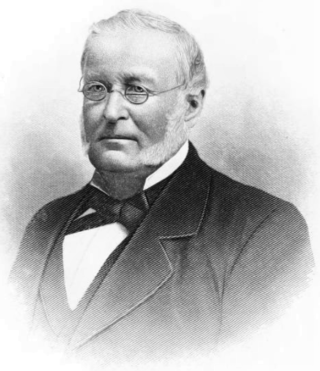
Joseph Farwell Glidden was an American businessman and farmer. He was the inventor of the modern barbed wire. In 1898, he donated land for the Northern Illinois State Normal School in DeKalb, Illinois, which was renamed as Northern Illinois University in 1957.

John Warne Gates, also known as "Bet-a-Million" Gates, was an American Gilded Age industrialist and gambler. He was a pioneer promoter of barbed wire. He was born and raised in what is now West Chicago, Illinois. He did not enjoy farm life and began offering neighbors various business propositions at an early age, including the sale of firewood to homes and to the local railroad. When he started a local grain brokerage that failed, Gates began spending time at the local railroad station and became reacquainted with the men he previously sold firewood to. He was invited to join their poker games and through this, Gates' aptitude for cards and other games of chance was developed.

Isaac Leonard Ellwood was an American rancher, businessman and barbed wire entrepreneur.

Jacob Haish was one of the first inventors of barbed wire. His type of barbed wire was in direct competition with the other barbed wire manufacturers in DeKalb, Illinois. He was a known carpenter and architect in DeKalb County and designed several prominent DeKalb homes.

The Ellwood House was built as a private home by barbed wire entrepreneur Isaac Ellwood in 1879. It is located on First Street in DeKalb, Illinois, United States, in DeKalb County. The Victorian style home, designed by George O. Garnsey, underwent remodeling in 1898-1899 and 1911. The house was originally part of 1,000 acres (4.0 km2) which included a large stable complex known as "Ellwood Green." Isaac Ellwood lived here until 1910 when he passed the estate to his son, Perry Ellwood.
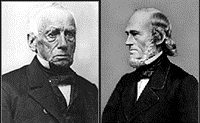
Ichabod Washburn (1798–1868) was an American Congregational deacon and industrialist from Worcester County, Massachusetts. His financial endowments led to the naming of Washburn College, now Washburn University in Topeka, Kansas and the foundation of Worcester Polytechnic Institute in Worcester, Massachusetts.

The Joseph F. Glidden House is located in the United States in the DeKalb County, Illinois city of DeKalb. It was the home to the famed inventor of barbed wire Joseph Glidden. The barn, still located on the property near several commercial buildings, is said to be where Glidden perfected his improved version of barbed wire which would eventually transform him into a successful entrepreneur. The Glidden House was added to the National Register of Historic Places in 1973. The home was designed by another barbed wire patent holder in DeKalb, Jacob Haish.
Clinton E. Rosette was a prominent citizen of DeKalb, Illinois, during the 19th century. Rosette was closely associated with well-known men from the same city, such as Isaac Ellwood. He was the first editor of the newspaper in DeKalb, the Daily Chronicle, a newspaper whose first publisher was barbed wire inventor Joseph Glidden. Today, a middle school bears his name.

The Bigelow Carpet Mill is an historic textile mill complex at Union and High Streets in Clinton, Massachusetts. Built in 1847 and repeatedly enlarged until 1922, this large mill complex was one of the world's major early automated manufacturers of Brussels tapestry, established by Horatio and Erastus Bigelow. The mill was listed on the National Register of Historic Places in 1978.

The Worcester Corset Company Factory is an historic factory building at 30 Wyman Street in Worcester, Massachusetts in the Main South neighborhood. The oldest part of the factory was built in 1895, with expansion of the facilities taking place up to 1909. The buildings were designed by Arthur F. Gray for the Worcester Corset Company, whose origins date to an 1861 business by David Hale Fanning making hoops for skirts, but shifted to manufacturing corsets after fashions changed. Fanning's business was immensely successful, and he became one of Worcester's larger employers. At one point it employed over 2000 women. After the Corset Company folded in 1940, the facility was used to manufacture military-style boots. The factory is now an apartment complex.

The Worcester Bleach and Dye Works is a historic factory complex at 60 Fremont Street in Worcester, Massachusetts. It consists of a pair of primarily brick factory buildings, one of which was built in 1909, and the other built later, between 1911 and 1922, for the named company, which was a major local manufacturer of thread. After the Bleach and Dye Works closed its doors in 1938, the complex has seen a succession of other owners.

The Whittall Mills is an historic industrial complex in southern Worcester, Massachusetts. The complex, which was built between 1870 and 1930, is a reminder of the large carpet manufacturing business that was once a major presence in the city. It is a complex of 15 brick buildings located on a bend of the Middle River, south of Crompton Street and just west of Interstate 290.

The Eric Bostrom Three-Decker is a historic triple decker house in Worcester, Massachusetts, United States. Built about 1894, it was listed on the National Register of Historic Places in 1990 for its elaborate Queen Anne porch woodwork, and eaves with decorative brackets. These features have been lost or obscured by subsequent exterior alterations.
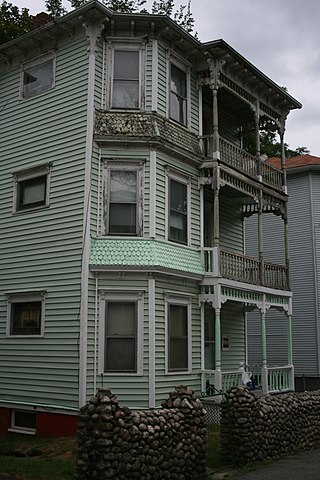
The Eric Carlson Three-Decker is a historic triple decker house in Worcester, Massachusetts. Built c. 1894, it is a well-preserved instance of the form with Queen Anne styling. It was listed on the National Register of Historic Places in 1990.
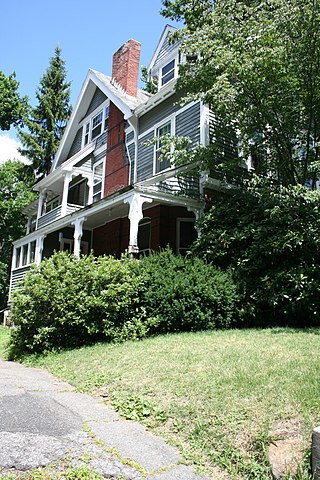
The Frederick Daniels House is a historic house at 148 Lincoln Street in Worcester, Massachusetts. Built about 1885, it is a well-preserved example of Queen Anne Victorian architecture, home to Frederick H. Daniels before he became president of Washburn and Moen, a leading Worcester industrial firm. It was listed on the National Register of Historic Places in 1980.
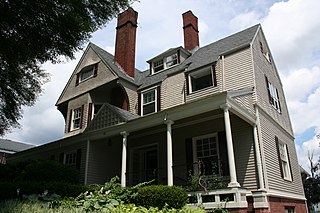
The Joseph Davis House is a historic house at 41 Elm Street in Worcester, Massachusetts. The Shingle style house was built in 1884 to a design by the Boston architectural firm of Peabody & Stearns, and is one of the most elaborate of that style in the city. It was built for Joseph Davis, the son of prominent Worcester lawyer Isaac Davis, and was home for many years to William Rice, president of the Washburn and Moen Company The house was listed on the National Register of Historic Places in 1980. It now houses professional offices.
Henry B. Sanborn was an American businessman, rancher, hotelier, horse breeder and philanthropist. He was known as the "Father of Amarillo, Texas."

Charles Hill Morgan was an American mechanical engineer, inventor, industrialist and President of the American Society of Mechanical Engineers in the year 1900–01. He is known for his contributions to Worcester and to the steel industry, especially to rod rolling.



